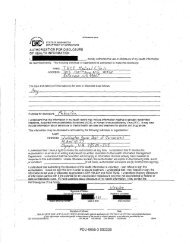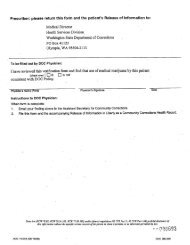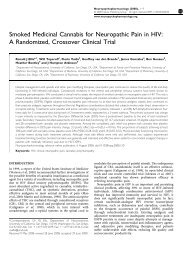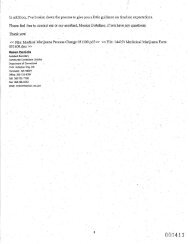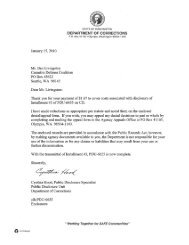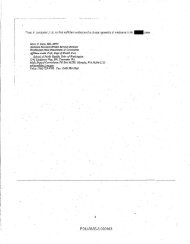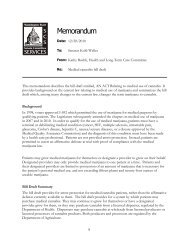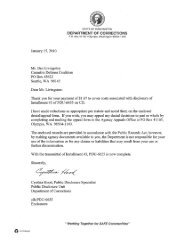Cannabis in painful HIV-associated sensory neuropathy
Cannabis in painful HIV-associated sensory neuropathy
Cannabis in painful HIV-associated sensory neuropathy
Create successful ePaper yourself
Turn your PDF publications into a flip-book with our unique Google optimized e-Paper software.
Table 2 Mean side effect scores by study groupAdjusted estimates<strong>Cannabis</strong>, mean(95% CI)Placebo, mean(95% CI)Anxiety* 0.25 (0.14, 0.44) 0.10 (0.05, 0.22)Sedation† 0.54 (0.36, 0.81) 0.08 (0.04, 0.17)Disorientation† 0.16 (0.07, 0.34) 0.01 (0.00, 0.04)Paranoia 0.13 (0.03, 0.45) 0.04 (0.01, 0.14)Confusion† 0.17 (0.07, 0.39) 0.01 (0.00, 0.06)Dizz<strong>in</strong>ess† 0.15 (0.07, 0.31) 0.02 (0.01, 0.05)Nausea 0.11 (0.04, 0.30) 0.03 (0.01, 0.14)Figure 3. Time course of the <strong>in</strong>tensity of chronic neuropathicpa<strong>in</strong> as rated on the daily diary VAS at 8 AM forthe previous 24-hour period. Each po<strong>in</strong>t represents thegroup median. Study admission was at noon on study day–2, the first cigarette was smoked at 2 PM on study day 1,and the last cigarette was smoked at 2 PM on study day 5.iety (p 0.04), sedation (p 0.001), disorientation (p 0.001), confusion (p 0.001), and dizz<strong>in</strong>ess (p 0.001).Although these differences were significant, the values forboth groups hovered closer to zero than one and do notrepresent any serious safety concerns <strong>in</strong> this short-termstudy. The Profile of Mood States <strong>in</strong>dicated a reduction <strong>in</strong>total mood disturbance dur<strong>in</strong>g the 5 days of smok<strong>in</strong>g (median33% cannabis vs 29% placebo; p 0.28). Althoughall subscale scores decl<strong>in</strong>ed <strong>in</strong> both groups, the only differencewas a larger decrease <strong>in</strong> depression-dejection <strong>in</strong> theplacebo group (median 63% cannabis vs 76% placebo;p 0.05, Mann-Whitney test).Discussion. Over a 5-day <strong>in</strong>patient <strong>in</strong>terventionperiod, smok<strong>in</strong>g cannabis cigarettes three times aFigure 4. First smok<strong>in</strong>g session: time course dur<strong>in</strong>g thefirst 95 m<strong>in</strong>utes after smok<strong>in</strong>g of <strong>in</strong>tensity of chronic pa<strong>in</strong>as measured on the visual analog scale (A; cannabis n 25, placebo n 25), pa<strong>in</strong>fulness of LTS (B; cannabis n 14, placebo n 16), and areas of secondary hyperalgesiato brush and von Frey hair stimulation (C and D; cannabisn 14, placebo n 16). Mean 95% CI.Side effects were rated three times daily on a 0 to 3 scale (0 none, 1 mild, 2 moderate, 3 severe).* p, 0.05; † p 0.001.day reduced <strong>HIV</strong>-SN pa<strong>in</strong> by 34%, significantly morethan the 17% reduction with placebo cigarettes. A30% reduction <strong>in</strong> pa<strong>in</strong> has been validated as a cl<strong>in</strong>icallysignificant level of improvement. 23 In the currentstudy, half (52%) of those randomized tocannabis experienced at least a 30% reduction <strong>in</strong>pa<strong>in</strong>, while a quarter (24%) of those randomized toplacebo experienced a similar reduction <strong>in</strong> pa<strong>in</strong>.In this randomized, placebo-controlled study, thenumber needed to treat (NNT) on the primary outcomemeasure of 30% pa<strong>in</strong> reduction among allcomplet<strong>in</strong>g patients was 3.6 (1/[52%24%]). Trialsvary <strong>in</strong> their primary outcome measure, so compar<strong>in</strong>gNNT figures only approximates relative potency.The NNT for lamotrig<strong>in</strong>e was 5.4 for <strong>HIV</strong>-relatedpa<strong>in</strong>ful DSP. 4,24 Although one group of <strong>in</strong>vestigatorsreported success with gabapent<strong>in</strong>, their data analysisdoes not allow calculation of an NNT. 5 The NNT<strong>in</strong> the present study is comparable to that reported<strong>in</strong> trials of gabapent<strong>in</strong> for other types of chronic neuropathicpa<strong>in</strong>. In a large study of gabapent<strong>in</strong> forpostherpetic neuralgia the NNT was 3.4 and for diabetic<strong>neuropathy</strong> the NNT was 4.0. 25,26 A recentmeta-analysis of 107 controlled trials for neuropathicpa<strong>in</strong> showed that only tricyclic antidepressants andhigher potency opioids consistently achieved NNTvalues lower than 3.7. 24 However, for <strong>HIV</strong>-SN, tricyclicantidepressants were not effective. 9,10 Opioidshave not been systematically evaluated for pa<strong>in</strong>ful<strong>HIV</strong>-SN, but studies show efficacy across a broadspectrum of neuropathic pa<strong>in</strong> disorders. 27,28In addition to patient-reported changes <strong>in</strong> ongo<strong>in</strong>gchronic pa<strong>in</strong>, smoked cannabis attenuated the cutaneoushyperalgesia <strong>associated</strong> with central neuronalsensitization produced by a standardized experimentalpa<strong>in</strong> model. Although one cannot entirely excludepa<strong>in</strong> relief due to relaxation, a high, or unbl<strong>in</strong>d<strong>in</strong>g,the mood effects recorded argue aga<strong>in</strong>st such an explanation.Only one of the six Profile of Mood Statessubscales (depression-dejection) showed a significantgroup difference, and actually favored placebo. Moreover,rat<strong>in</strong>gs of side effects <strong>in</strong> the cannabis groupFebruary 13, 2007 NEUROLOGY 68 519




